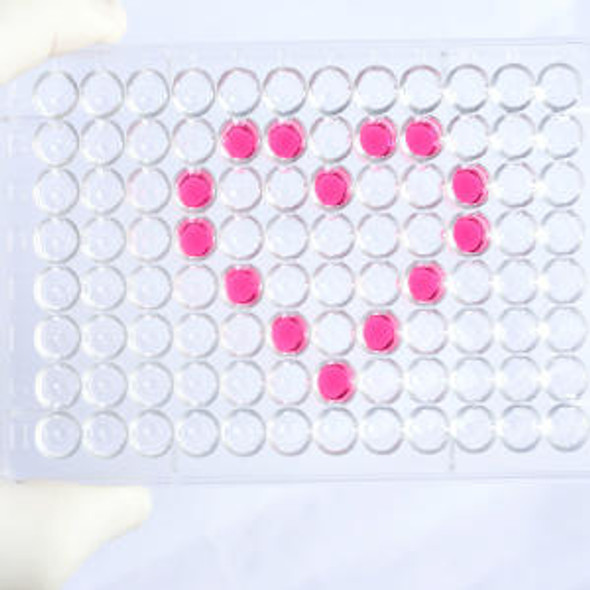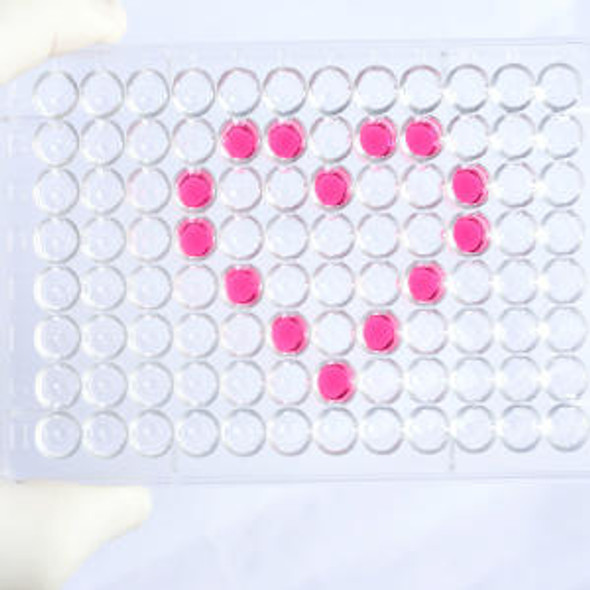Description
Human TYMS (Thymidylate synthase) ELISA
TYMS (Thymidylate Synthetase) inhibitors are a class of cancer medications. They work by blocking the action of an enzyme called thymidylate synthetase. This enzyme is involved in the manufacture of DNA, which is necessary for cell division. Diseases associated with TYMS include Mucositis and Rectum Cancer. Among TYMS related pathways are E2F mediated regulation of DNA replication and Pyrimidine metabolism. The Assay Genie Human TYMS (Thymidylate synthase) ELISA is a highly sensitive assay for the quantitative measurement of TYMS (Thymidylate synthase) in serum, blood, plasma, cell culture supernatant and tissue samples.
| Product Name: | Human TYMS (Thymidylate synthase) ELISA Kit |
| Product Code: | HUFI08064 |
| Size: | 96 Assays |
| Alias: | HsT422 ELISA Kit, Thymidylate synthase ELISA Kit, thymidylate synthetase ELISA Kit, TMS ELISA Kit, TS ELISA Kit, TSase ELISA Kit, TYMS ELISA Kit |
| Detection method: | Sandwich ELISA, Double Antibody |
| Application: | This immunoassay kit allows for the in vitro quantitative determination of Human TYMS (Thymidylate synthase) concentrations in serum plasma and other biological fluids. |
| Sensitivity: | < 0.094ng/ml |
| Range: | 0.156-10ng/ml |
| Storage: | 4°C for 6 months |
| Note: | For Research Use Only |
| Recovery: | Matrices listed below were spiked with certain level of Human TYMS (Thymidylate synthase) and the recovery rates were calculated by comparing the measured value to the expected amount of Human TYMS (Thymidylate synthase) in samples. | ||||||||||||||||
| |||||||||||||||||
| Linearity: | The linearity of the kit was assayed by testing samples spiked with appropriate concentration of Human TYMS (Thymidylate synthase) and their serial dilutions. The results were demonstrated by the percentage of calculated concentration to the expected. | ||||||||||||||||
| |||||||||||||||||
| CV(%): | Intra-Assay: CV<8% Inter-Assay: CV<10% |
| Component | Quantity | Storage |
| ELISA Microplate (Dismountable) | 8×12 strips | 4°C for 6 months |
| Lyophilized Standard | 2 | 4°C/-20°C |
| Sample/Standard Dilution Buffer | 20ml | 4°C |
| Biotin-labeled Antibody(Concentrated) | 120ul | 4°C (Protect from light) |
| Antibody Dilution Buffer | 10ml | 4°C |
| HRP-Streptavidin Conjugate(SABC) | 120ul | 4°C (Protect from light) |
| SABC Dilution Buffer | 10ml | 4°C |
| TMB Substrate | 10ml | 4°C (Protect from light) |
| Stop Solution | 10ml | 4°C |
| Wash Buffer(25X) | 30ml | 4°C |
| Plate Sealer | 5 | - |
Other materials and equipment required:
- Microplate reader with 450 nm wavelength filter
- Multichannel Pipette, Pipette, microcentrifuge tubes and disposable pipette tips
- Incubator
- Deionized or distilled water
- Absorbent paper
- Buffer resevoir
| UniProt Protein Function: | TYMS: an enzyme in the thymidylate synthase family. Polymorphisms serve as prognostic markers for determining modality of treatment in certain cancers. Genotyping helps predict toxicity to 5-FU-based chemotherapy in patients with colorectal cancer and the response to platinum-based chemotherapy in advanced NSCLC. A common polymorphism is a determinant of red blood cell folate and homocysteine concentrations. Homodimer. |
| UniProt Protein Details: | Protein type:Nucleotide Metabolism - pyrimidine; Cofactor and Vitamin Metabolism - one carbon pool by folate; DNA repair, damage; EC 2.1.1.45; Mitochondrial; Methyltransferase Chromosomal Location of Human Ortholog: 18p11.32 Cellular Component: nucleoplasm; mitochondrion; mitochondrial matrix; cytoplasm; mitochondrial inner membrane; nucleolus; nucleus; cytosol Molecular Function:mRNA binding; protein homodimerization activity; nucleotide binding; drug binding; cofactor binding; thymidylate synthase activity; folic acid binding Biological Process: immortalization of host cell by virus; methylation; tetrahydrofolate metabolic process; circadian rhythm; uracil metabolic process; developmental growth; response to organophosphorus; response to toxin; response to glucocorticoid stimulus; dTTP biosynthetic process; response to vitamin A; pyrimidine base metabolic process; response to folic acid; nucleobase, nucleoside, nucleotide and nucleic acid metabolic process; aging; response to drug; organ regeneration; nucleobase, nucleoside and nucleotide metabolic process; dTMP biosynthetic process; deoxyribonucleoside monophosphate biosynthetic process; G1/S-specific transcription in mitotic cell cycle; response to ethanol; response to cytokine stimulus; cartilage development; pyrimidine nucleoside biosynthetic process; dUMP metabolic process; mitotic cell cycle; response to progesterone stimulus; G1/S transition of mitotic cell cycle |
| NCBI Summary: | Thymidylate synthase catalyzes the methylation of deoxyuridylate to deoxythymidylate using 5,10-methylenetetrahydrofolate (methylene-THF) as a cofactor. This function maintains the dTMP (thymidine-5-prime monophosphate) pool critical for DNA replication and repair. The enzyme has been of interest as a target for cancer chemotherapeutic agents. It is considered to be the primary site of action for 5-fluorouracil, 5-fluoro-2-prime-deoxyuridine, and some folate analogs. Expression of this gene and that of a naturally occuring antisense transcript rTSalpha (GeneID:55556) vary inversely when cell-growth progresses from late-log to plateau phase. [provided by RefSeq, Jul 2008] |
| UniProt Code: | P04818 |
| NCBI GenInfo Identifier: | 136611 |
| NCBI Gene ID: | 7298 |
| NCBI Accession: | P04818.3 |
| UniProt Secondary Accession: | P04818,Q8WYK3, Q8WYK4, |
| UniProt Related Accession: | P04818 |
| Molecular Weight: | Calculated MW: 26kDa/31kDa/35kDaObserved MW: 36kDa |
| NCBI Full Name: | Thymidylate synthase |
| NCBI Synonym Full Names: | thymidylate synthetase |
| NCBI Official Symbol: | TYMS |
| NCBI Official Synonym Symbols: | TS; TMS; HST422 |
| NCBI Protein Information: | thymidylate synthase; TSase |
| UniProt Protein Name: | Thymidylate synthase |
| Protein Family: | Thymidylate synthase |
| UniProt Gene Name: | TYMS |
| UniProt Entry Name: | TYSY_HUMAN |
*Note: Protocols are specific to each batch/lot. For the correct instructions please follow the protocol included in your kit.
Before adding to wells, equilibrate the SABC working solution and TMB substrate for at least 30 min at 37 °C. When diluting samples and reagents, they must be mixed completely and evenly. It is recommended to plot a standard curve for each test.
| Step | Protocol |
| 1. | Set standard, test sample and control (zero) wells on the pre-coated plate respectively, and then, record their positions. It is recommended to measure each standard and sample in duplicate. Wash plate 2 times before adding standard, sample and control (zero) wells! |
| 2. | Aliquot 0.1ml standard solutions into the standard wells. |
| 3. | Add 0.1 ml of Sample / Standard dilution buffer into the control (zero) well. |
| 4. | Add 0.1 ml of properly diluted sample ( Human serum, plasma, tissue homogenates and other biological fluids.) into test sample wells. |
| 5. | Seal the plate with a cover and incubate at 37 °C for 90 min. |
| 6. | Remove the cover and discard the plate content, clap the plate on the absorbent filter papers or other absorbent material. Do NOT let the wells completely dry at any time. Wash plate X2. |
| 7. | Add 0.1 ml of Biotin- detection antibody working solution into the above wells (standard, test sample & zero wells). Add the solution at the bottom of each well without touching the side wall. |
| 8. | Seal the plate with a cover and incubate at 37 °C for 60 min. |
| 9. | Remove the cover, and wash plate 3 times with Wash buffer. Let wash buffer rest in wells for 1 min between each wash. |
| 10. | Add 0.1 ml of SABC working solution into each well, cover the plate and incubate at 37 °C for 30 min. |
| 11. | Remove the cover and wash plate 5 times with Wash buffer, and each time let the wash buffer stay in the wells for 1-2 min. |
| 12. | Add 90 µL of TMB substrate into each well, cover the plate and incubate at 37 °C in dark within 10-20 min. (Note: This incubation time is for reference use only, the optimal time should be determined by end user.) And the shades of blue can be seen in the first 3-4 wells (with most concentrated standard solutions), the other wells show no obvious color. |
| 13. | Add 50 µL of Stop solution into each well and mix thoroughly. The color changes into yellow immediately. |
| 14. | Read the O.D. absorbance at 450 nm in a microplate reader immediately after adding the stop solution. |
When carrying out an ELISA assay it is important to prepare your samples in order to achieve the best possible results. Below we have a list of procedures for the preparation of samples for different sample types.
| Sample Type | Protocol |
| Serum | If using serum separator tubes, allow samples to clot for 30 minutes at room temperature. Centrifuge for 10 minutes at 1,000x g. Collect the serum fraction and assay promptly or aliquot and store the samples at -80°C. Avoid multiple freeze-thaw cycles. If serum separator tubes are not being used, allow samples to clot overnight at 2-8°C. Centrifuge for 10 minutes at 1,000x g. Remove serum and assay promptly or aliquot and store the samples at -80°C. Avoid multiple freeze-thaw cycles. |
| Plasma | Collect plasma using EDTA or heparin as an anticoagulant. Centrifuge samples at 4°C for 15 mins at 1000 × g within 30 mins of collection. Collect the plasma fraction and assay promptly or aliquot and store the samples at -80°C. Avoid multiple freeze-thaw cycles. Note: Over haemolysed samples are not suitable for use with this kit. |
| Urine & Cerebrospinal Fluid | Collect the urine (mid-stream) in a sterile container, centrifuge for 20 mins at 2000-3000 rpm. Remove supernatant and assay immediately. If any precipitation is detected, repeat the centrifugation step. A similar protocol can be used for cerebrospinal fluid. |
| Cell culture supernatant | Collect the cell culture media by pipette, followed by centrifugation at 4°C for 20 mins at 1500 rpm. Collect the clear supernatant and assay immediately. |
| Cell lysates | Solubilize cells in lysis buffer and allow to sit on ice for 30 minutes. Centrifuge tubes at 14,000 x g for 5 minutes to remove insoluble material. Aliquot the supernatant into a new tube and discard the remaining whole cell extract. Quantify total protein concentration using a total protein assay. Assay immediately or aliquot and store at ≤ -20 °C. |
| Tissue homogenates | The preparation of tissue homogenates will vary depending upon tissue type. Rinse tissue with 1X PBS to remove excess blood & homogenize in 20ml of 1X PBS (including protease inhibitors) and store overnight at ≤ -20°C. Two freeze-thaw cycles are required to break the cell membranes. To further disrupt the cell membranes you can sonicate the samples. Centrifuge homogenates for 5 mins at 5000xg. Remove the supernatant and assay immediately or aliquot and store at -20°C or -80°C. |
| Tissue lysates | Rinse tissue with PBS, cut into 1-2 mm pieces, and homogenize with a tissue homogenizer in PBS. Add an equal volume of RIPA buffer containing protease inhibitors and lyse tissues at room temperature for 30 minutes with gentle agitation. Centrifuge to remove debris. Quantify total protein concentration using a total protein assay. Assay immediately or aliquot and store at ≤ -20 °C. |
| Breast Milk | Collect milk samples and centrifuge at 10,000 x g for 60 min at 4°C. Aliquot the supernatant and assay. For long term use, store samples at -80°C. Minimize freeze/thaw cycles. |
Fill out our quote form below and a dedicated member of staff will get back to you within one working day!






